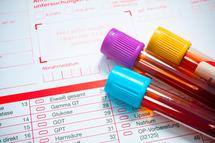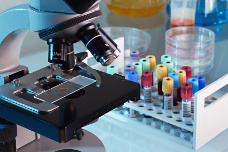Blood tests
Author: Gesche Tallen, MD, PhD, Editor: Maria Yiallouros, Reviewer: Prof. Dr. med. Ursula Creutzig, English Translation: Hannah McRae, Last modification: 2015/01/13 https://kinderkrebsinfo.de/doi/e30790
Blood tests help doctors define the diagnosis of many childhood cancers. Also, they help monitoring a patient's response to treatment as well as detecting and managing the side-effects of chemotherapy, such as immunosuppression and anaemia.The following blood components are regularly checked prior, during and after a cancer treatment:

A child's drawing
- Complete blood count (CBC): the determination of all blood cells such as red and white blood cells and platelets
- White blood cell count (WBC): the number of leucocytes (white cells) counted per cubic millimeter of blood that circulates in the body (peripheral blood)
- Differential count (diff): the distribution of the different white cells in the peripheral blood
- Platelet count: the number or quantity of platelets per cubic millimeter of peripheral blood
- Haemoglobin: the molecule in red blood cells that carries oxygen to other tissues of the body. It is measured in percent of total blood weight and helps the doctors to monitor the suppression of bone marrow function caused by a cancer or its treatment
- Blood group: the classification of the patient's blood type based on the presence or absence of inherited markers on the surface of red blood cells (RBCs). Its determination is particularly important prior to a blood transfusion
- Blood proteins: the proteins found in the blood, that have various important functions in the body, such as transporting other substances like vitamins, lipids, metals and hormones, participating in immune responses as well as in blood coagulation, regulating fluid balance and many more
- Electrolytes such as sodium, potassium, phosphor, magnesium, to monitor the patient's fluid balance, nutritional condition and kidney function. Also, even slight electrolyte imbalances at certain timepoints of treatment can be early indicators of complications caused by cancer treatment or the disease itself, respectively, such as tumour lysis syndrome
- Blood gases: to determine the acid alkaline balance of the blood, and the partial pressure of carbon dioxide and oxygen as indicators of lung function
- Kidney, liver, pancreatic, endocrinological and other specific organ parameters to monitor organ functions and the patient's hormone status
- Blood coagulation factors need to be determined especially prior to surgery or treatment with certain chemotherapeutic drugs, since disorders of coagulation can result in an increased risk of bleeding (haemorrhage) or obstructive clotting (thrombosis)
- Blood glucose level (blood sugar concentration): refers to the amount of glucose in the blood and partially represents a patient's, that can be elevated during treatment with glucocorticoids, for example during induction therapy of acute lymphoblastic leukaemia. Therefore, it has to be monitored to be able to maintain the patient's glucose balance
- Infectious diseases parameters refer to the presence of bacteria and certain virus antibodies in the blood as indicators of the patient's immune status or an acute viral or bacterial infection, respectively
- Tumour markers: substances, elevated blood levels of which can be indicative of a certain cancer
- Molecular markers: refer to gene- or protein alterations in blood cells, that have been proven to be of prognostic relevance for patients with certain blood cancers. Based on the presence of such prognostic factors, patients can be stratified into specific risk-groups receiving more intensive therapy
- Levels of chemotherapeutic drugs in the blood to monitor the patient's treatment tolerance, thereby preventing overdosage and resulting severe side-effects


